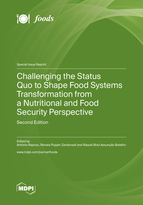Challenging the Status Quo to Shape Food Systems Transformation from a Nutritional and Food Security Perspective: Second Edition
A special issue of Foods (ISSN 2304-8158). This special issue belongs to the section "Food Security and Sustainability".
Deadline for manuscript submissions: closed (31 January 2023) | Viewed by 88996
Special Issue Editors
Interests: food safety; food security; food innovation; natural food products; nutrition; public health
Special Issues, Collections and Topics in MDPI journals
Interests: diet; food; foodservice; nutrition; plant-based; gluten-free; sustainability
Special Issues, Collections and Topics in MDPI journals
Interests: dietetics; food allergies; food development; foodservice; sustainability
Special Issues, Collections and Topics in MDPI journals
Special Issue Information
Dear Colleagues,
For decades, food security and nutrition have been prominent elements of the international development agenda. Over time, however, development priorities and challenges have oscillated, and the investment required has not been sustained. A wider consensus has appeared: one that guarantees food security and, in all its aspects, reduces hunger and malnutrition to promote strong economies, human and planetary health, and sustainable development. Our moral imperative is to positively change food systems to ensure that the food we produce is accessible, sustainable, safe, healthy, and equitable for everyone.
Taking into account these premises, and since the topicality of the subject remains emerging and attracts great demand and interest, as demonstrated in the first edition of this Special Issue (https://www.mdpi.com/journal/foods/special_issues/Challenging_Food_Security), we decided to launch a second edition that aims to present original research articles, reviews, and short communications concerning the following:
- Access: affordability, allocation, and preference of food;
- Availability: the production, distribution, and exchange of food;
- Circularity in food systems at local, regional, or global levels;
- Development, impact, and ethics of novel and data-driven technologies in food systems;
- Food security and policy, governance, institutions, and trade;
- Influencing food consumption and demand considering the food environment;
- Stability and dynamics of food security aspects;
- Sustainable food systems and agro-ecological food production;
- Utilization: the nutritional value, social value, and safety of food.
Dr. António Raposo
Prof. Dr. Renata Puppin Zandonadi
Prof. Dr. Raquel Braz Assunção Botelho
Guest Editors
Manuscript Submission Information
Manuscripts should be submitted online at www.mdpi.com by registering and logging in to this website. Once you are registered, click here to go to the submission form. Manuscripts can be submitted until the deadline. All submissions that pass pre-check are peer-reviewed. Accepted papers will be published continuously in the journal (as soon as accepted) and will be listed together on the special issue website. Research articles, review articles as well as short communications are invited. For planned papers, a title and short abstract (about 100 words) can be sent to the Editorial Office for announcement on this website.
Submitted manuscripts should not have been published previously, nor be under consideration for publication elsewhere (except conference proceedings papers). All manuscripts are thoroughly refereed through a single-blind peer-review process. A guide for authors and other relevant information for submission of manuscripts is available on the Instructions for Authors page. Foods is an international peer-reviewed open access semimonthly journal published by MDPI.
Please visit the Instructions for Authors page before submitting a manuscript. The Article Processing Charge (APC) for publication in this open access journal is 2900 CHF (Swiss Francs). Submitted papers should be well formatted and use good English. Authors may use MDPI's English editing service prior to publication or during author revisions.
Keywords
- Agro-ecological
- Consumer
- Environment
- Food policy
- Food production
- Food safety
- Food security
- Nutrition
- Sustainability









